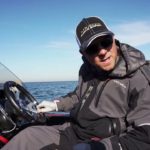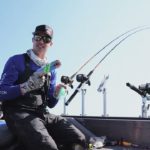Lighting Up Dark Water Walleyes
 Not all good walleye water is of the crystal clear pristine variety, if fact some of the best options are downright dark. Walleyes inhabit a wide range of lakes, rivers, and reservoirs, and their size and makeup can vary greatly, including water clarity. The present clarity can have a definitive effect on exactly where walleyes can be found and just how active they might be. Dark or stained is even preferred in many situations, and there are a number of good solid reasons for keeping dark water at the top of your “to do” list.
Not all good walleye water is of the crystal clear pristine variety, if fact some of the best options are downright dark. Walleyes inhabit a wide range of lakes, rivers, and reservoirs, and their size and makeup can vary greatly, including water clarity. The present clarity can have a definitive effect on exactly where walleyes can be found and just how active they might be. Dark or stained is even preferred in many situations, and there are a number of good solid reasons for keeping dark water at the top of your “to do” list.
It’s preferred because darker water walleyes can be much more approachable than those inhabiting the drinking water variety. They’re more approachable because they are less apt to visibly detect your presence, which allows for close contact. Under certain situations you can get almost on top of them, which makes for some exciting angling. Walleyes can be unbelievably scrappy when hooked on a short line in shallow water, and in fact their antics are more likely to be associated with that of a northern pike or a largemouth bass. If the water is dark enough the identity of the species hooked may not be known until it’s brought to the boat. The morale of this story is to play every fish as if it’s a walleye as you never know for sure.
Another detractor to walleyes found in a clear water environment is the possibility that they may be spending at least part of their time feeding under the cloak of darkness.
Angling after the sun goes down can pay big dividends and may be your best option, but unless your willing to give up a lot of sleep in order to be there when you need to be a dark water option may be the best thing going.
Dealing with dark water walleyes requires some variations in basic presentations like lure selection and color. The key is appealing to enough of their senses that your bait gets noticed and accepted. Baits that have proven to be effective in dark water include those that produce plenty of noise like crankbaits, spinners, jigs, and even smaller spinner baits.
 A small spinner and plastic combination like Northland Tackle’s Slurpies Swim Shiner is an excellent search lure and can be used to cover some water. Cast it to the edges of reed banks, over the tops of cabbage beds, across a rocky bar or reef, or up on top of a shallower flat and work it back. The basic design is relatively weed less and snag resistant which means you can work into and through a lot of cover without constantly hanging up. A spinner and jig combination like the Thumper Jig is another great search lure and can be worked up and over cover, and down to and along the bottom. It can be tipped with a plastic trailer or a minnow, or maybe a piece of crawler, and will still produce flash and vibration but can be worked nice and slow.
A small spinner and plastic combination like Northland Tackle’s Slurpies Swim Shiner is an excellent search lure and can be used to cover some water. Cast it to the edges of reed banks, over the tops of cabbage beds, across a rocky bar or reef, or up on top of a shallower flat and work it back. The basic design is relatively weed less and snag resistant which means you can work into and through a lot of cover without constantly hanging up. A spinner and jig combination like the Thumper Jig is another great search lure and can be worked up and over cover, and down to and along the bottom. It can be tipped with a plastic trailer or a minnow, or maybe a piece of crawler, and will still produce flash and vibration but can be worked nice and slow.
Standard jigs are another good choice for dark and stained water and definitely have a time and place. While you wouldn’t necessarily think of a jig as noise bait, there is sound created when a jig is crawled across the bottom, especially if it’s make up is rock or gravel. Another method involves using a heavier jig like a 3/8 or ½ ounce model and thumping the bottom with a simple lift and drop. That thumping can draw in hungry ‘eyes, and is surprisingly effective. Rather than trying to get the bait to them
you can actually call fish to dinner and pull walleyes in from a long distance.
A spinner and crawler harness trolled behind a bottom bouncer is another great option for covering water, especially when walleyes move into deeper water. Deep is a relative term and may mean no more than five or six feet, and could also include twenty or more. The thing is with a bouncer like a two ounce Rock Runner and a Rainbow Spinner tipped with a crawler you can move along and cover a lot of ground. The Rock’n Rainbow is a new twist on the standard spinner rig and comes in some awesome colors and has a crazy action that will produce the ultimate in vibration and will definitely get noticed.
Color is an important consideration regardless of what you’re using and some of it borders on bade taste. It would seem that the gaudier colors are more effective and include chartreuse, fluorescent orange, red and pink, as well as white, and any combination of the above. When it comes to spinners, another good dark water blade that shouldn’t be overlooked is hammered brass or gold. A white blade or a blade with a white back can also be effective, especially if white bass and shad makeup part of the available forage. Colors to stay away from would be more of the natural variety as they are more likely to blend in, and the whole idea is to get noticed. See you on the water.





